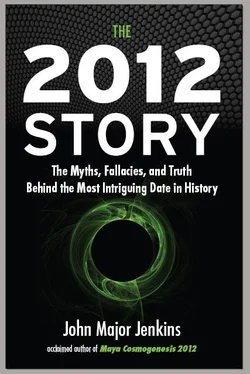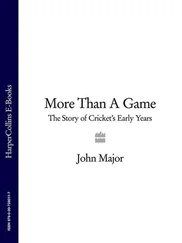830 AD.Ending of Baktun 10; Classic Maya civilization begins failing.
909 AD.Last carved Long Count monument, from Toniná: 10.4.0.0.0.
1000 AD.The Long Count calendar tradition continues in manuscript form, with Long Count dates and distance numbers recorded in the Maya’s Dresden Codex, Madrid Codex, and Paris Codex.
1100 AD-1500 AD.Katun counting is preserved in Yucatán. A Short Count form of the Long Count (a 13-Katun May -cycle, or Prophecy cycle) is implemented.
1224 AD.Baktun 11 ending, probably noted in Yucatán.
1520s-1570s.The Conquest. Maya books are burned. Bishop Diego de Landa active in Yucatán, writes his Relacion de los cosas de Yucatan.
1520s-1700s.The Chilam Balam prophecy books are compiled by Maya leaders in Yucatán. They contain much earlier Katun prophecies and other historical information.
1550s.The Hero Twin Myth ( The Popol Vuh ) recorded by Quiché elders in Guatemala.
1618.Baktun 12 ending celebrated in Yucatán.
1697.The Itza Maya finally acquiesce to Spanish rule in Flores, Petén.
1700.Francisco Ximénez translates The Popol Vuh in Guatemala.
1752.Short Count system recalibrated in Yucatán, changing the 20-year Katun cycle to a 24-year cycle. The continuity of the Katun sequencing is affected.
1761.Maya reform leader Jacinto Canek captured, tortured, and killed by Spanish army in Mérida, along with many of his followers.
1770s-1790s.Spanish travelers take note of ancient ruins of Palenque.
1810s. Memory of pre-1752 placement of Short Count tradition dies with elders.
1800-1820s.Explorers such as Count Waldeck visit Maya sites.
1839.Catherwood and Stephens record monuments at Copán and Quiriguá containing Long Count glyphs.
1860s.Brasseur de Bourbourg publishes The Popol Vuh and de Landa’s Relacion .
1880s.Maudslay makes high-quality photographs of Maya monuments, including Long Count inscriptions.
1880s.Förstemann decodes the Dresden Codex in Germany.
1897.Goodman’s appendix to Maudslay published, containing free-floating charts for Long Count dates.
1905.Joseph T. Goodman publishes “Maya Dates” in American Anthropologist . This is the correlation of the Maya and Gregorian calendars that would be confirmed in the 1920s.
1926-1927.Juan Martínez Hernández and J. Eric S. Thompson confirm Goodman’s work, producing the original GMT (Goodman-Martínez-Thompson) correlation.
1927.Thompson publishes an article with a chart that could be extrapolated to reach an estimated cycle ending of December 23, 2012, but this never appears to have been done. The cycle ending remained unstated in the literature until Coe’s 1966 book The Maya .
1920s-1940s.Ethnographic evidence for the survival of the 260-day tzolkin calendar in the Guatemalan highlands is documented. Invites a reassessment of the correlation by Thompson.
1946.Morley’s The Ancient Maya is published, with incomplete Long Count tables, using the original GMT correlation.
1950.Thompson revises the original GMT by 2 days. The result brings the 13-Baktun cycle ending into alignment with December 21, 2012, although the fact has yet to be stated in the literature.
1956.The second edition of Morley’s The Ancient Maya contains updated Long Count tables, using the revised GMT-2 correlation, but the tables are still incomplete.
1966.Michael Coe’s The Maya is published. It is the first source to mention the 13-Baktun cycle ending of the Long Count, but the book miscalculates it as December 24, 2011 AD.
1967.William S. Burroughs mentions 2012 in a parody magazine, according to the findings of John Hoopes.
1975.The cycle ending is treated fully by Frank Waters in his Mexico Mystique , but he used Coe’s 2011 date. McKenna mentions 2012 in The Invisible Landscape . Argüelles mentions 2012 in The Transformative Vision .
1975-1990.Argüelles develops his Maya calendar system and associates Tony Shearer’s 1987 Harmonic Convergence date with a “twenty-five-year countdown” to 2012. McKenna is elaborating his Time Wave Zero model, now connected to December 21, 2012. Peter Balin mentions 2012 in his 1978 book Flight of the Feathered Serpent ; Peter Tompkins mentions 2011 in his 1976 book Mysteries of the Mexican Pyramids . Barbara Tedlock mentions 2012 in her 1982 book Time and the Highland Maya . Argüelles’s The Mayan Factor appears in 1987.
1988.Maya scholar Munro Edmonson writes, in his Book of the Year , that the solstice placement of the cycle ending in 2012 was unlikely to be a coincidence. For almost two decades after this other scholars asserted, when asked, that it must be a coincidence.
1992.John Major Jenkins publishes his book Tzolkin , which offered a method by which shifting seasonal quarters were tracked in the Long Count, suggesting how December 21, 2012, might have been targeted.
1992-1993.Linda Schele’s breakthrough work on hieroglyphic decipherments, Maya Creation Mythology, and astronomy.
1991-1995.Popular books on the Mesoamerican calendar, such as The Mayan Prophecies and Scofield’s Day-Signs, start appearing. Argüelles’s Dreamspell system released in late 1991.
1994.Jenkins publishes his 2012 alignment theory, connecting the era-2012 alignment of the December solstice sun and the dark rift to Maya Creation Mythology and astronomy. Research culminates in the 1998 relase of his book Maya Cosmogenesis 2012, offering a full reconstruction of the origins and intention of the Long Count/2012 cosmology.
1998.Geoff Stray’s Internet site Diagnosis 2012 is founded and becomes an indispensable resource for reviews and insights on all things 2012.
2000-2009.An explosion of books, films, and websites devoted to 2012 flood the marketplace. Scholars, Maya elders, popular writers, the New York Times , and documentaries cover and comment on 2012.
2005.Geoff Stray’s book Beyond 2012 is published.
2005.Victor Montejo’s Maya Intellectual Renaissance is published. Discussion of the indigenous “Baktunian movement.”
2006.Robert Sitler publishes “The 2012 Phenomenon,” the first academic treatment of the topic.
2006, April.The 2012 text from Tortuguero is translated and discussed, with varying opinions on its importance.
2007.Michael Grofe completes his PhD dissertation, which argues convincingly for accurate knowledge of the rate of the precession of the equinoxes in the Dresden Codex.
2008.Barb MacLeod offers her “3-11 Pik formula,” detailing a precession-based mechanism in the Classic Period inscriptions used by Maya kings.
2009, February.The first academic 2012 conference takes place, held at Tulane University in New Orleans.
2009, February-March.New discoveries on dark-rift astronomy and 2012 connections at Tortuguero and Copán made by Grofe and Jenkins (see Chapter 7).
Читать дальше












